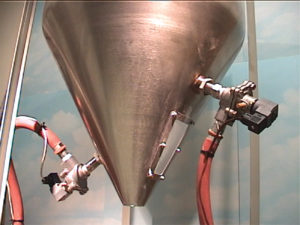
AirSweep can solve even the most challenging material flow problems—and it’s so easy to install and maintain too. The system can be set up in just a few days and can be attached with simple tools on any kind of vessel.
Here are some of the most frequently asked questions that people ask about installing an AirSweep system and integrating it into their process.
Where is the AirSweep Installed?
AirSweep is attached outside of the vessel. Only the nozzle tip comes in direct contact with the material, and the nozzle closes after each short pulse to minimize material feedback. This makes the system more hygienic and prevents damage to the rest of the system.
How is the AirSweep Installed?
AirSweep can be installed in four simple steps.
- CUT holes where the couplings will be welded. It can also be retrofitted into existing holes in vessels that previously used other flow aids.
- WELD the couplings into place
- INSTALL the AirSweep by threading into coupling, and tightening the lock nut once the proper insertion depth is reached.
- CONNECT the pulse valve with a flex hose to a rigid header that connects to the air supply
The only tricky part is aligning the vessel, and making sure that the nozzle reaches the proper depth. This video demonstrates it clearly.
Is There an Option to Install AirSweep Without Welding It to the Vessel?
You can use the AirSweep outside-in mounting bracket. The kit has all the parts you need, and it can be installed with just a spanner wrench and a small 1-3/8″ diameter hole.
The brackets are available in three sizes, to accommodate the different models. This option is available for all AirSweep models: VA-06 for small vessels, VA-12 for medium to large vessels, and VA-51 for large vessels.
The bracket is recommended for people who want to:
- Minimize modifications to the vessel
- Easily remove the nozzle for cleaning
- Install the flow aid as quickly as possible
Can AirSweep Be Installed on Different Kinds of Vessels?
Yes. AirSweep can be installed in any vessel or area where material has a tendency to hang up. Aside from silos, hoppers, and other material storage containers, it can be placed in gravity chutes, fine grinding mills, extruders, pneumatic convey lines, cyclones, pipes (including elbows and bends), cyclones, and more.
AirSweep can also be installed on:
- Thin vessels that would normally be damaged by agitators, vibrators, or air cannons
- Concrete vessels
- Very small vessels—even as small as 300 millimeters
- Very large vessels
In short, AirSweep can work on any type, size, and material of vessel. We just adjust the system’s pressure and pulse frequency to accommodate any constraints.
How Do I Prepare the Vessel Before Installation?
You do not need to make any changes to the vessel before installing the AirSweep system. It does not require any vessel coating or lining to work. It has such powerful activation that it can move material even on a rough surface.
If your vessel has material, empty it out below the level of where you are installing the nozzle. It can prevent material from spilling while you are drilling the hole and welding on the couplings. However, if you are using aggregate material that won’t spill out, you can actually install the units on a full vessel—if you don’t mind the installation debris.
If sanitation or contamination is a concern, clean out the debris with water or flushing material. You can also use high-pressure cleaning since it won’t affect the AirSweep in any way. The air nozzles are tightly sealed and no water can get in them. In this video, we actually submerged the unit in water to demonstrate its dust-tight, waterproof design.
What Kind of Air Supply Do We Need?
AirSweep can work with any type of pressurized plant air. We recommend treating the air before it goes to the system to avoid introducing moisture into the product.
The key factor is not the type of air that is used but maintaining the correct air pressure and volume. This video explains why.
Where Should I Place the AirSweep Units?
It depends on your material and process. Our engineers will analyze your material flow problem, recommend the best solutions, and then provide a diagram that shows the proper placement, air pressure, and pulse frequency and intervals.
They can also answer any questions you may have about installation—and typically reply in one business day. You can also find the installation guides for your AirSweep model, or watch the installation videos.
Contact us if you have any questions about AirSweep and how it can be integrated into your process.





Comments are closed